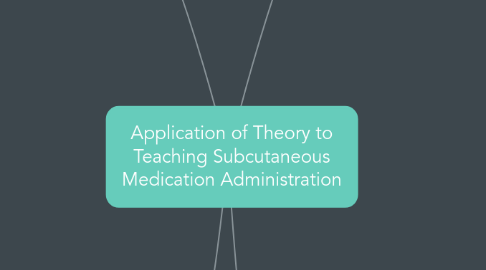
1. Constructivist Learning Theory
1.1. Theorists
1.1.1. Bandura - Social Learning Theory
1.1.2. Vygotsky - Sociocultural Learning Theory
1.1.3. Piaget
1.1.4. Bruner - Constructivist Theory
1.2. View of Knowledge
1.2.1. Gained by utilizing past and new knowledge
1.2.1.1. Review concepts such as medication administration and sterile technique
1.2.2. Dynamic and ongoing process
1.2.3. Built as a result of a student connecting meaning to an experience
1.3. View of Learning
1.3.1. Assimilation: Comparing new experiences and information to known information
1.3.2. Accommodation: Changing mental processes and schemas based on new information and experiences
1.3.3. Active Process
1.3.4. Learners are responsible for the knowledge gained
1.3.4.1. Self evaluations and reflection of skills
1.3.5. Internal process
1.4. Role of the Student
1.4.1. Active participation is a must for learning to occur
1.4.2. Autonomy & control over learning
1.4.3. Learning is focused on the student, not the educator
1.4.3.1. Provide resources such as text & videos that can be utilized by students at any time
1.5. Role of the Educator
1.5.1. Create an engaging environment for students
1.5.2. Function as a facilitator of learning
1.5.2.1. More of a hands-off approach
1.6. Teaching Scenarios
1.6.1. Group Projects
1.6.1.1. Create a poster board with pictures demonstrating the steps of subcutaneous injection
1.6.2. Case Studies
1.6.3. Role Playing
1.6.3.1. Have students pair together and demonstrate how to administer subcutaneous injection
1.6.4. Mind Mapping
1.6.4.1. Create a Mind Map describing the indications, contraindications, side effects, and proper method of subcutaneous injections
1.6.5. Interactive Lectures
1.6.6. Reflective Questions
2. Adult Learning Theory
2.1. Theorist
2.1.1. Malcolm Knowles
2.2. View of Knowledge
2.2.1. Andragogy - education of adults
2.2.2. Adult learn differently from children
2.2.2.1. Important concept, as some nursing programs have a large population of non-traditional students
2.3. View of Learning
2.3.1. Use knowledge and experiences to apply learning to real world scenarios
2.3.1.1. Students will administer subcutaneous injections frequently as a nurse
2.3.1.2. Adult learners typically join nursing as a second career, they will have previous experiences to build on
2.3.2. Problem Centered learning
2.3.3. Learning should be relevant and important to objectives and real world situations
2.4. Role of the Student
2.4.1. Self Directed learning
2.4.2. Characteristics of Adult Learners
2.4.2.1. Adult learners have other roles and responsibilities
2.4.2.1.1. Jobs, children, elderly parents, finances
2.4.2.2. Adult learners learn by participating
2.4.2.2.1. Provide active learning opportunities
2.4.2.3. Meaning of life is constantly being re-evaluated and adjusted based off of knowledge and learning
2.4.2.4. Adult learners may be anxious about their learning
2.4.2.4.1. Adult learners may not have been in a classroom for decades
2.5. Role of the Educator
2.5.1. Focus is on the learner, not the educator
2.5.2. Educators should create lesson plans that engage students and provide meaningful learning
2.5.3. Encourage reflection and connection to past knowledge
2.5.4. Educators are a support to the student
2.6. Teaching Scenarios
2.6.1. Independent Study
2.6.1.1. Allow students to review subcutaneous injections independently
2.6.2. Internships
2.6.3. Clinical Experiences
2.6.3.1. Have students administer a subcutaneous injection
2.6.4. Reflective Journals
2.6.5. Portfolios
3. Behavioral Learning Theory
3.1. Theorists
3.1.1. Skinner - Operant Conditioning
3.1.2. Edward Thorndike
3.1.2.1. Cats learning to escape from puzzle boxes
3.1.3. Pavlov - Classical Conditioning
3.1.3.1. Ding, Food, Salivate
3.2. View of Knowledge
3.2.1. All behaviors are learned
3.2.1.1. No major focus on knowledge, just learning
3.3. View of Learning
3.3.1. Learning is achieved by associating a stimulus with a response
3.3.1.1. External influence
3.3.1.2. Behavioral
3.3.2. Learning cues, practice, and reinforcement
3.3.2.1. Reinforced responses are remembered and repeated
3.3.3. Step-by-step guidelines and objectives
3.3.3.1. 1. Collect 3ml syringe, blunt needle, alcohol swab
3.3.3.2. 2. Obtain medication via first medication administration check
3.3.3.3. 3. So on...
3.3.4. Scientific Learning
3.4. Role of the Student
3.4.1. Motivation is based off of reward and punishment
3.4.1.1. "If you do this correctly, you will get an A+. If you miss a step, you fail"
3.4.2. Student focus is on meeting guidelines and objectives,
3.4.2.1. Little abstract thinking
3.4.3. Feedback can increase self-efficacy
3.5. Role of the Educator
3.5.1. Educator designs experience, facilitates in the learning environment
3.5.2. Provides ongoing positive and negative feedback to influence learning
3.5.2.1. Reward and Punishment
3.6. Teaching Scenarios
3.6.1. Behavioral objectives
3.6.1.1. Observable and measurable
3.6.1.1.1. Pass or fail tasks
3.6.2. Immediate feedback
3.6.2.1. Positive or negative response in real time
3.6.2.1.1. Ex: Student breaks sterile technique, immediate negative feedback OR
3.6.2.1.2. Ex. Student maintains sterility, positive feedback
3.6.3. Simulation and clinical evaluation
3.6.3.1. Observe outcomes!
3.6.3.1.1. Ex. Student successfully injects heparin subcutaneously, observed by educatior
4. Cognitive Learning Theory
4.1. Theorists
4.1.1. Gagne - Conditions of Learning
4.1.2. Ausubel - Subsumption Theory
4.2. View of Knowledge
4.2.1. Emphasis moves away from the what/behaviors to the how and why
4.2.1.1. Less memorization, less repetition
4.2.1.1.1. Ex. Why do we use a 25 g needle for a subcutaneous injection?
4.2.1.1.2. Ex. Why do we insert the needle at a 45 degree angle?
4.2.2. The mind has schemas and knowledge units that increase in number as the student learns
4.3. View of Learning
4.3.1. Active and ongoing process
4.3.2. Prior learinng, information processing, storage retrieval, & activation
4.3.3. Goal oriented
4.3.4. Sensory register
4.3.4.1. Short term memory
4.3.4.1.1. Long term memory!
4.4. Role of the Student
4.4.1. Active and Internal learning
4.4.2. Make connections between what is known and what is new
4.5. Role of the Educator
4.5.1. Guiding students in how to think, not just do
4.6. Teaching Scenarios
4.6.1. Reflect in one's own words
4.6.1.1. Ex. Write down the steps to complete a subcutaneous injection in your own words
4.6.2. Clinical Post Conferences
4.6.3. Simulation Debriefings
4.6.3.1. "The patient screamed in pain during the subcutaneous heparin injection, can someone tell me why?"
4.6.3.1.1. Sally used a 16 gauge :(
4.6.4. Case Studies
